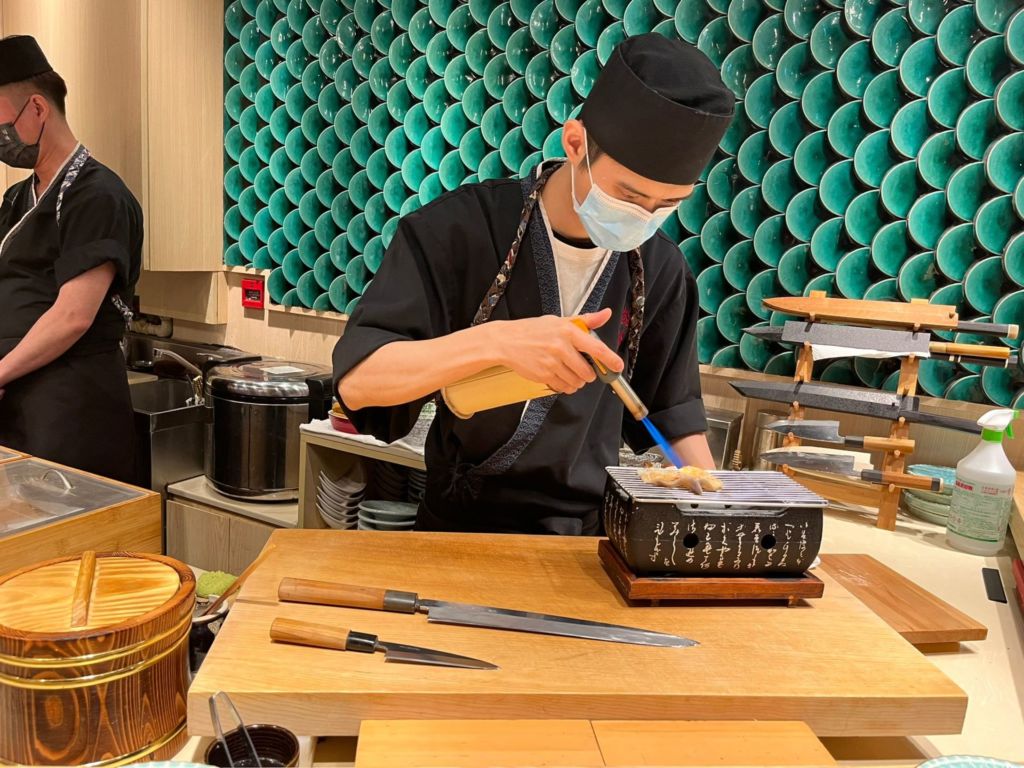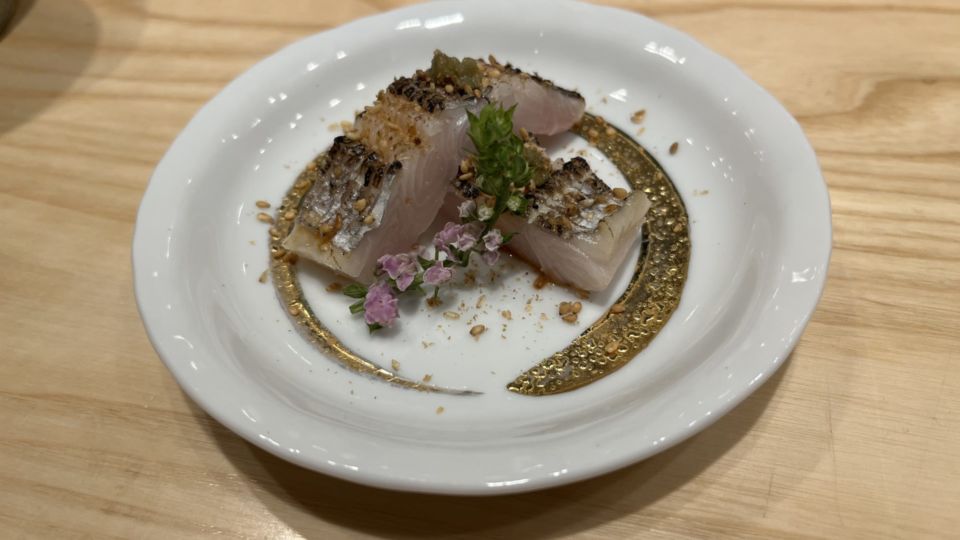Due to the strict dining restrictions caused by the pandemic, which have only recently begun to ease, it has become commonplace to see restaurants fold in Hong Kong.
But one type of eatery that has continued opening in large numbers is Japanese omakase restaurants. And it seems like Hongkongers just can’t get enough of them.
Japanese for “I’ll leave it up to you”, omakase has come to represent a type of high-end restaurant serving dishes based on the chef’s selection of fresh and seasonal ingredients of the day. Courses are mostly sushi or sashimi, but can also include hot dishes.
Like my fellow Hong Kong foodies, I was thrilled when I was invited to a tasting at Sushi Rin, which has outlets in Sheung Wan and Tsim Sha Tsui. I went to the Sheung Wan location, which features simple but cozy decor.
The first dish I tried was the appetizer, featuring Spaghetti Squash from Okayama, Black Baigai from Yamaguchi and Smoked Yellow Pickled Radish with Cream Cheese.
The lovely variety of flavors and textures awakened my taste buds for the meal.
Next up were seven sashimi dishes.
The chef who attended to me was chef Leung, who thoroughly explained the dishes and ingredients throughout the meal.
The first was the Suzuki (Sea Bass) from Shizuoka.
The sea bass had a mild and delicate taste, which was slightly briny and sweet.
Next was the Ishigakigai (Castle Stone Clam) from Iwate.
I was delighted to try this clam as it is only in season for one to two months. It tasted like geoduck but was lighter and sweeter. Before serving, chef Leung gave the clam a light pat, which caused it to contract, giving it a crunchier texture.
He also prepared another clam dish, the Hokkigai (Surf Clam) from Hokkaido.

Using a blow torch, chef Leung lightly seared the clam to further bring out its sweetness.
After the lighter dishes, we moved on to richer sashimi.
After searing the Kuromutsu (Japanese bluefish) from Kanagawa, the chef seasoned the fish slices with soy sauce and wrapped them around thin green spring onion shoots before presenting them on a beautiful crescent-shaped plate. The green spring onion shoots’ sharpness complemented the fish’s luscious and deep marbling of fat.
You know how it’s always a bit difficult choosing between briny and creamy oysters? You get the best of both worlds with the Oyster from Konbumori, which was crunchy and briny on top and creamy and meaty on the bottom. Both flavors were accentuated with a slightly spicy and sour sauce prepared by the chef.
Next up was the Kanpachi (Greater Amberjack) Belly from Tokyo Bay, which was beautifully seared and seasoned, giving it a salty fragrance.
This was followed by the Tachiuo (Largehead Hairtail) from Mie, which was seasoned with sake and sea salt, and garnished with a sprig of shiso flowers. The skin was seared to give it a crispy texture.
Next was a detour to two hot dishes to freshen my palate.
They include the sweet and fresh Horsehair Crab from Hokkaido and the Sake Abalone, which was soft and flavorful.
We then continued with a delectable range of sushi.
The White Squid from Nagasaki was finely chopped, allowing it to mix better with the rice.
Next was the Saba (Chub Mackerel) from Nagasaki, which was rich and flavorful. Because it was fresh, it did not have a fishy taste.
I also got to try the Akamutsu (Blackthroat Seaperch) from Kyushu, which is not served in many restaurants due to its steep price. It was fatty and tender.
Next up were two tuna dishes: the Chu-Toro of Wild Tuna from Kyoto and O-Toro of Wild Tuna from Kyoto.
Both were delicious, but it was the chu-toro that really stood out for me.
The chu-toro, which is the belly area of the tuna along the side of the fish, was fatty but not as fatty as o-toro. However, it had a stronger tuna flavor, which came through the tendons.
The o-toro, which is the fattiest portion of the tuna, is found on the very underside of the fish. The one I tried had rich fats melting in my mouth.
The last sushi dish was the Purple Sea Urchin from Hokkaido.
I’m not usually a fan of sea urchins due to their fishy taste, but this one did not disappoint.
As you can see in the photo, the sea urchin was firm and vibrant in color, meaning it was fresh. It also melted in my mouth and had a mild, but not fishy, taste of the ocean.
The meal concluded with the Miso Soup and the Matcha Pudding.
The pudding had a rich and lovely matcha flavor, ending the meal on a sweet note.
With such strong competition, it is difficult to stand out in Hong Kong’s growing omakase scene. But Sushi Rin does so with its wide variety of fresh ingredients sourced from across Japan, as well as delicately crafted dishes tailor-made to highlight the catch of the day.
Sushi Rin Sheung Wan, Shop D, G/F, 126-128 Jervois Street, Sheung Wan. Call 2567 1168 to make a booking. The dinner omakase set tried for the tasting costs HK$1,680 (US$214).




